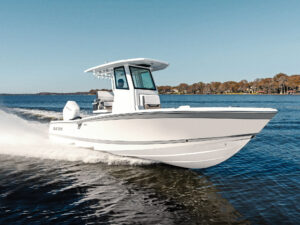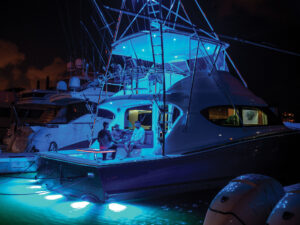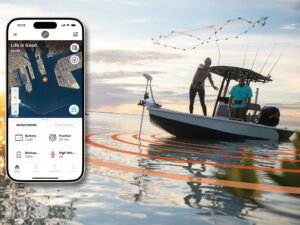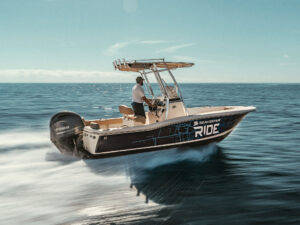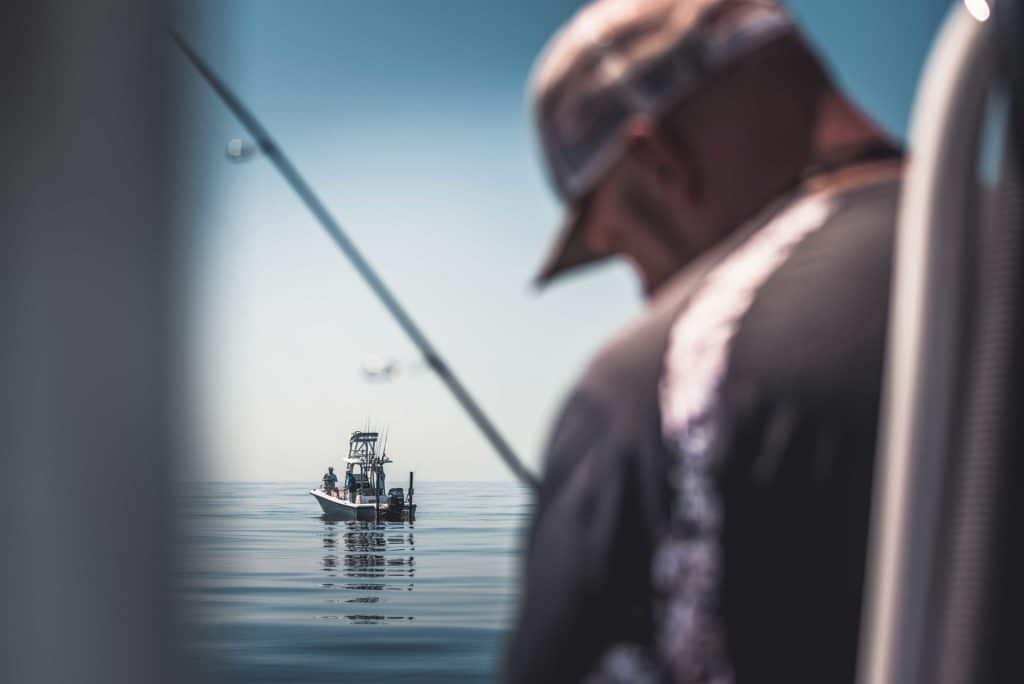
You’ve read dozens of reviews, spent two days at the boat show, taken a couple of test rides, and finally picked the one. But your new boat is far from ready to go fishing. First, you must outfit your ride with the correct accessories and safety gear. We asked three boat-business veterans to share their picks of essentials and most desirable add-ons.
With years of experience rigging hundreds of boats, the experts agree on one thing: Choose the best electronics, accessories and safety gear to avoid frustration and have more success on the water.
Must-Haves
Josh Murphy, owner of Norfolk Marine in Virginia, has seen rigging and outfitting get easier and more affordable. “The biggest advancement is integration of electronics from different companies,” he says. An owner can purchase a fish finder from one manufacturer, a radar from another, and a navigation system from a third company, then run all systems from a single multifunction display. Nonetheless, most new-boat buyers are installing matching electronics packages from one manufacturer. “The quality and performance of each brand is excellent across the board,” he says, so anglers don’t have to buy from different brands to get the best unit.
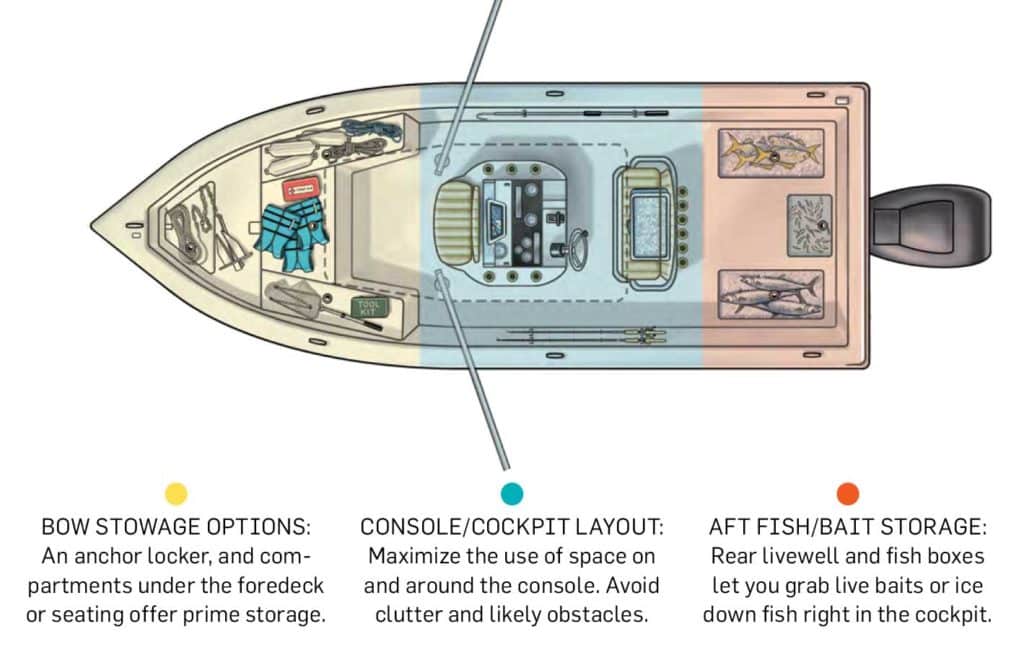
Murphy says his customers are looking for the latest features, such as side-scan and midband chirp sonar, and navigation systems with satellite-connected weather radar and water-temperature overlay, which now come standard on many new chart plotters. For inshore boats, 360 or forward-seeing sonar is becoming more popular, especially units with a transducer that mounts on a trolling motor, which work best in water shallower than 30 feet.
Murphy is particularly impressed with broadband radar, which he says is virtually as sensitive as traditional open-array radar and better suited for small boats. Solid-state radar produces less microwave emission and provides a clearer image of weather, obstacles and shore, he says. The closed systems have no moving parts and come in a smaller package perfect for smaller boats.
With today’s electronics, “the sky is the limit,” Murphy claims. The latest models let you control the boat systems, including sound and security, and monitor the vessel’s vitals from anywhere. Onboard cameras and high-water and temperature sensors even allow you to keep track of conditions when you’re not on board. “It’s all controlled through an app on your smartphone,” Murphy says.
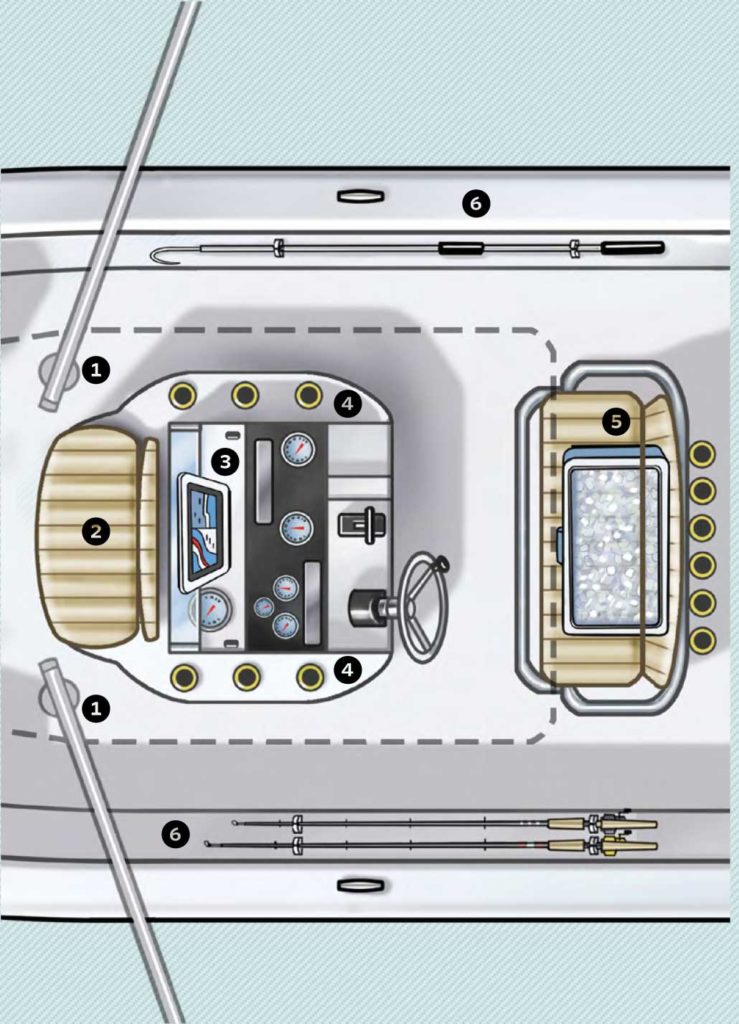
Including factory-installed electronics into your boat deal could save you time and headaches, especially if you lack experience in that department. Plus, retrofitting a boat later is often more costly.
Outrigger Choices
With accessories, “the key is getting the best stuff right off the bat, so you don’t have to replace gear continually,” says Keith Fraser, owner of tackle retailer Alltackle.com. If trolling is part of your fishing plans, you’ll need outriggers, and he says there are great options for smaller boats now. For boats under 25 feet, manufacturers recommend 15-foot poles, while boats from 26 to 30 feet should go with 18-footers. “But carbon-fiber poles are lighter and stiffer, allowing anglers to use longer riggers.”
Docking and Anchoring Needs
Dock lines should not be overlooked, and neither should the right anchor and rode. Aside from dock lines to assist with launching the boat, carry a lead line slightly longer than the waterline to bring the boat from the trailer to the dock. In addition, two shorter ropes and a couple of boat bumpers will keep your new ride from being damaged.
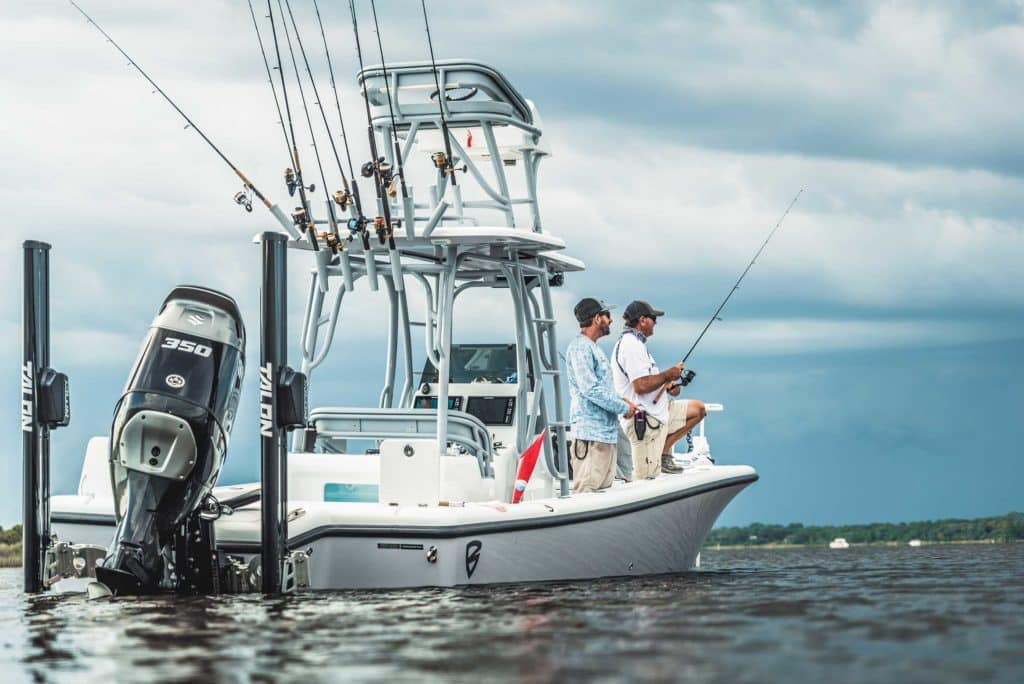
To anchor a boat up to 30 feet, Fraser recommends 3/8-inch three-strand nylon rope at least three times the length of the deepest water in which you plan to anchor, and longer if you often anchor in deep areas or places with strong prevailing winds or currents. Add a length of 5/16-inch chain to resist abrasion and help the anchor dig into the bottom. Danforth anchors are easier to store, but not as reliable on soft bottom as a claw-style Bruce anchor.
Fraser reminds customers that an anchor is essential safety gear if the boat loses power. “So keep a backup anchor on board,” he says.
For the same reason, Fraser recommends an appropriately sized drift sock, which besides slowing a boat’s drift, will also keep the bow into the wind and waves, and help maintain a safe, slower drift in case of a breakdown.
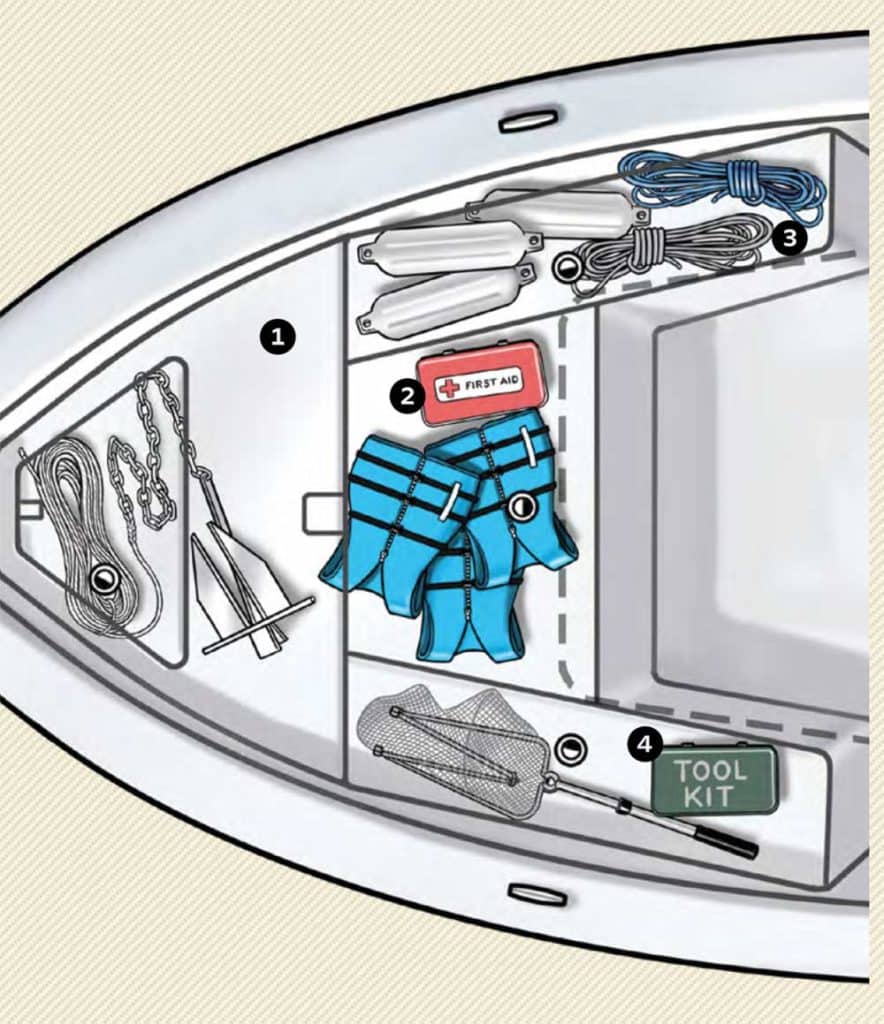
For quick anchoring in shallow water, anglers are rigging skiffs and bay boats with power-anchoring systems. Push a button, and the extendable poles stick into the soft bottom to hold the boat quickly and quietly, and in the perfect position for casting. In deeper water, users partially deploy the poles to control how the boat drifts. To achieve the best results, many new owners are installing two poles, one on each side of the engine.
Bay boats and skiffs are often rigged with a high-powered trolling motor. Location lock is one of Fraser’s favorite features. The trolling motor is integrated with the GPS to hold the boat in position with a push of a button. Most models can be operated with a key fob for hand- and foot-free control.
Dry and Cold Storage
One thing in short supply on most boats is storage. Whether it’s dry storage, tackle storage or cold storage, capitalize on space to make the most of what’s available.
One of Fraser’s favorite add-ons is a locking, waterproof tackle-storage system. The hard-plastic cases can be mounted anywhere on the boat and accommodate a half-dozen traditional tackle trays. To prevent corrosion on lures and terminal tackle, the latest boxes produce a chemical that coats the contents in a thin film.
Cold storage is critical on any fishing boat. Many boats come with in-deck fish boxes, but the crew still needs room for bait and lunch.
Fraser says modern supercoolers pack extra insulation to keep contents cold for days. Coolers seem to take the most abuse on a boat, so look for one with a metal bar through the hinge, and rubber latches that won’t break off. To keep bait frozen without a freezer, place a soft-sided cooler inside a hard cooler and pack both with ice.
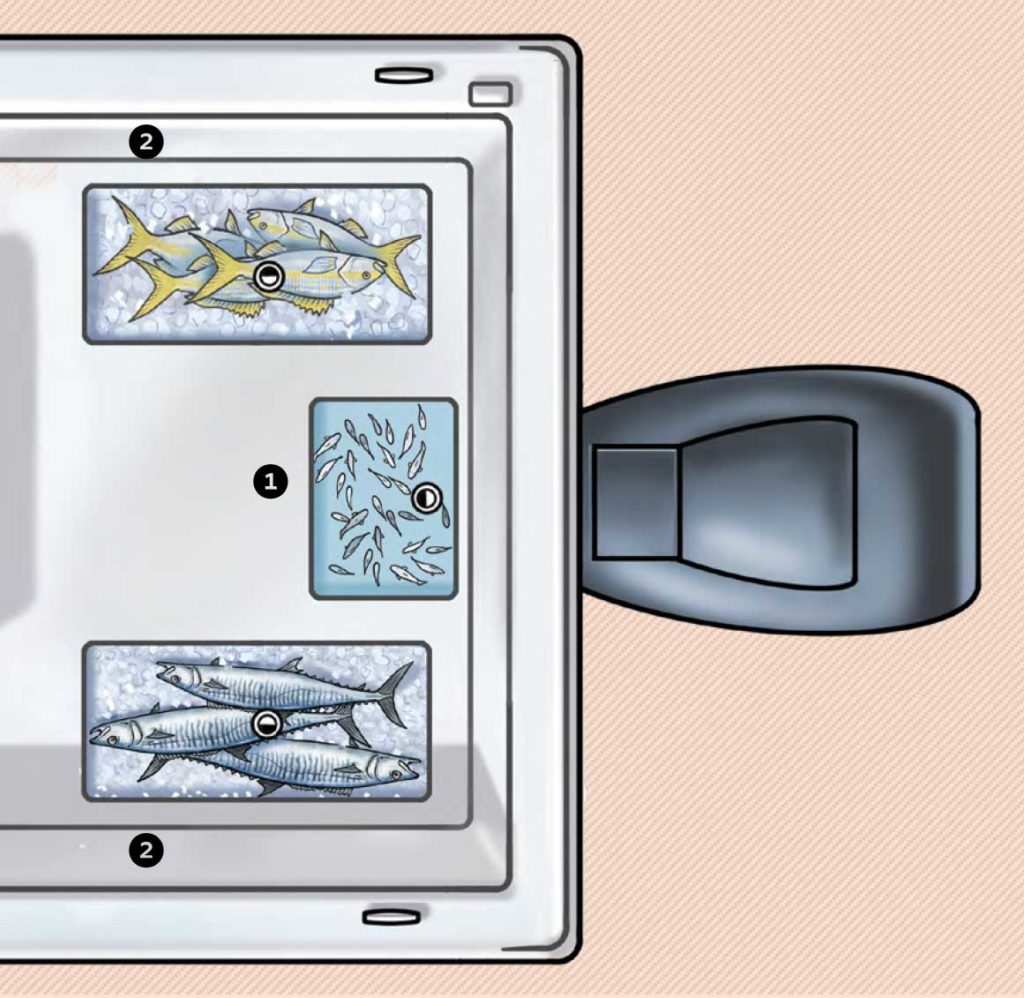
Fraser recommends an insulated fish bag for bigger fish. “Most are species-specific,” he points out. There are long, narrow models for wahoo, king mackerel or other long fish that might not fit in the fish box. And always store lunch in a separate cooler. Fraser sees new boaters using soft-sided coolers for food and a separate, hard cooler for drinks. He suggests stocking the lunch cooler with ice packs, which are colder than regular ice, and won’t leave food swimming in meltwater.
Tools of the Trade
For most applications, two gaffs are a good idea. One should have a 2-inch bite for smaller fish, the other a 4-inch bite for the big catches. A 6- to 8-foot handle is ideal for smaller boats.
At least one landing net is also important. Based on the size of the fish you intend to target, pick one with a 24- to 40-inch hoop, and a collapsible handle for easier storage.
Scissors are the safest way to cut line and bait, so keep a lighter pair with curved blades for line and light wire, and heavy shears with straight blades for cutting bait chunks.
Two fillet knives—a sturdy model for cutting bone and thick skin, and a flexible blade for slicing the meat away from the bone and skin—are minimum cutlery needs. A shorter, serrated knife will take care of cutting bait. Keep knives sharp with a hardened tungsten carbon sharpener. Pack a steel file for keeping hooks sharp.
Short-nose pliers provide more torque to pull knots tight, while long-nose pliers are better for digging a hook out of a fish. And don’t forget a dehooker for quick and safe hook removal.
Also carry a well-stocked toolkit that includes standard ratchets and box wrenches, wire crimps, and a voltage meter for minor repairs, along with a few spare parts for on-the-water emergencies.
Lighting
Besides the required white anchor light and green and red navigation lights, Fraser says many owners are adding fishing and accent lights. Inside the boat, white LED lights offer the best visibility, while red or colored lights protect night vision. To see navigation aids and obstacles in the dark, carry an LED spotlight. LEDs are the best choice for marine lighting because the small lamps are sealed from the elements and produce very little heat.
Safety Gear
No one knows more about the pitfalls of powerboating than Ed Schrader, a Sea Tow franchise owner in Hampton Roads, Virginia. After years of rescuing wayward boaters, he’s seen it all. “Advanced materials and systems make boats safer,” he says, but that doesn’t mean emergencies won’t happen. Schrader stresses, “The best way to stay out of trouble is to learn to use the systems and don’t take safety for granted.”
In addition to the minimum safety and rescue equipment required by the Coast Guard, Schrader recommends a 25-watt VHF radio with a Maritime Mobile Service Identity (MMSI) number to make it easier for tow services to find the boat. A handheld 5-watt VHF comes in handy for closer communications and if the user has to exit the boat. “Be sure you know how to read the boat location on the GPS,” he says.
Cellphones are great for nearshore communication, but limited battery life makes them less reliable. Always carry an external charger to power the phone if the boat loses power.
In addition to housing one Type III life vest for each person on the boat (and appropriate kids life jackets), many anglers are opting to wear an inflatable life jacket. Whether a vest or belt-worn model, inflatables are low-profile and lightweight. When the wearer hits the water, a CO₂ canister inflates rubber bladders to provide flotation.
Schrader encourages boaters to carry a satellite rescue beacon. An EPIRB with a powerful GPS signal will alert rescue services anywhere on the globe. On a smaller scale, a handheld personal locator beacon can be carried in a life-jacket pocket. A signal whistle and strobe lights further improve communication in a rescue event.
To round out safety equipment, Schrader suggests a portable bilge pump and battery charger. To plug a leak, he carries silicone tape and foam footballs. Cable ties can save the day, he adds. On-the-water injuries miles and hours from help require a well-stocked first-aid kit and survival blankets. Schrader also carries extra water in case the day lasts longer than expected. “Most important,” he adds, “don’t forget to put in the bilge plug.”
The list of gear may seem long and expensive, but equipping the boat with the right stuff not only improves safety but also increases enjoyment. Powerboating involves a lot of moving parts and requires great responsibility. Outfit the boat properly to ensure years of worry-free fishing and enjoyment.

